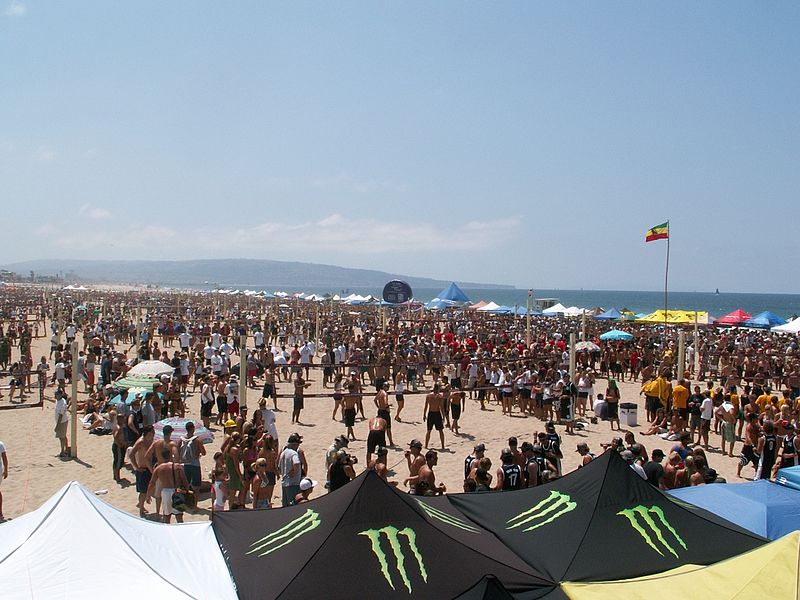
Manhattan Beach Six-Man Volleyball Tournament. Courtesy of Wikimedia Commons, Licensed under CCO 3.0.
Soon it will be August in New York City, a period when everyone is theoretically out of town—they’re always saying this, anyway, in books like August by Judith Rossner. This is mostly a fiction, that everyone’s at their country house and everything is shutting down, but it’s sort of fun to imagine; who doesn’t secretly enjoy having fun while others are away? For the month of August, the Review is trying a little experiment—highlighting some things that are going on during this supposedly quiet month. Every week, we’ll be compiling roundups of cultural events and miscellany that the Review’s staff and friends are excited about around town. (And maybe, occasionally, out of town.) We can promise only that these lists will be uncomprehensive, totally random, and fun.
F. W. Murnau’s Faust, introduced by Mary Gaitskill at Light Industry, August 1: Gaitskill, who was interviewed for the Spring issue of the Review, will be introducing this 1926 silent film, which, like many flops, is now a cult classic. Gaitskill saw a clip of the film online years before she had read Goethe’s novel, though she knew the basic outlines of the story of the scholar who made a pact with the devil. “That was enough for me to understand and to feel, to believe, the reality of the segment: the flailing despair, the futile vanity, the experience of running through a live, tactile murk of demons and uncomprehending humans, moving slo-mo through their own fates, trying to undo something that can’t be undone,” she told Light Industry.
Heji Shin’s “The Big Nudes” at 52 Walker, open all August: “The Big Nudes” is the photographer Heji Shin’s first solo exhibition in New York since the 2020 show “Big Cocks.” The cocks in question, by the way, were a series of roosters photographed in shocking detail. “The Big Nudes,” meanwhile, will include photographs of pigs posed to evoke fashion models. This show comes recommended by our contributing editor Matthew Higgs, who says, “This relatively rare gallery presentation promises to be something of a midsummer event.” It opened recently and will be up through October 7.
“Live Jerry Garcia Band Set Lists” by the Garcia Project at Brooklyn Bowl, August 5: Recommended by friend of the Review and occasional Review softball first baseman Adam Wilson, this will be an attempt to faithfully re-create actual set lists played by the Jerry Garcia Band between 1976 and 1995. If you never had a chance to see Jerry’s soulful side project live, this is probably the closest you will ever come to it, and real Deadheads will tell you—at great length, if you’d like—that JGB is actually, sometimes, even better than the Dead.
New York City Estate Auction at Auctions at Showplace, preview beginning July 26, auction on August 6: A Jasper Johns lithograph? An Edwardian platinum diamond necklace? An unspeakably tacky oil painting of a blue butterfly? All listed for prices so low they’re unbelievable, which is true, because they’re likely to climb exponentially over the course of the auction. (Or will they?) There’s really nothing like an auction for a dose of randomness, serendipity, and pure gambling thrill; this one collects objects from private estates all over New York City. At the very least, it’s worth a stop by the preview showing, just in case …
Bargemusic: Complete Beethoven Violin and Piano Sonatas on the East River, August 5: An idea from site contributor Elena Saavedra Buckley that is third-date-worthy: go see music at the barge-turned-floating-concert-hall moored in Brooklyn Bridge Park and then go to Sunny’s, the best summer bar in Brooklyn, where there is also likely to be music on a Saturday night. Be on guard, however, if you are seasick or faint of heart, warns the Bargemusic website: “Please be aware that although we are permanently moored, the Barge is in navigable waters and sways with the movement of the East River.”
Charlie Saikley Six-Man Volleyball Tournament, Manhattan Beach, August 6: This is, of course, in Manhattan Beach, but for those who happen to be in Los Angeles, our engagement editor Cami Jacobson’s dad will be playing in this legendary annual tournament. Manhattan Beach is apparently “the home of beach volleyball”; this annual tournament is apparently a mix of Very Serious players and people in pink trucker hats who are there for a good time. Jacobson describes the vibe as “very crowded, everyone you have ever met is there, like your whole high school class.”
Triple feature: The Godfather, The Godfather Part II, and The Godfather Coda at Metrograph, August 6: Very rarely can you watch all three Godfather films in one place in a single day. Perhaps not that many people have ever even done this, anywhere. But on a Sunday in early August, Metrograph is showing all three, with a merciful break between parts two and three for dinner. Our web editor, Sophie Haigney, will be there, hiding from the heat.
Also recommended by editors and friends of the Review for this week: Free admission at the Noguchi Museum on August 4 (Lori Dorr); free Indigo de Souza concert in Prospect Park on August 4 (Amanda Gersten and Alejandra Quintana Arocho); Patrick Carroll’s show “Commonplacing” at Bill Cournoyer through August 5 (Spencer Quong); stop by “Visual Volumes: Contemporary Explorations in Book Arts,” all month at the Center for Book Arts (Alejandra Quintana Arocho); Mingus Big Band will be playing two sets every Monday in August at The Dom (Lexy Benaim); fireworks at the Coney Island boardwalk every Friday of August (Lori Dorr); Carly Rae Jepsen on the roof at Pier 17 on August 7 (Amanda Gersten).
from The Paris Review https://ift.tt/0hIOCZH
Comments
Post a Comment